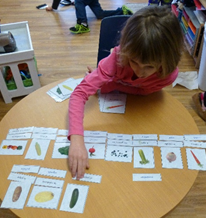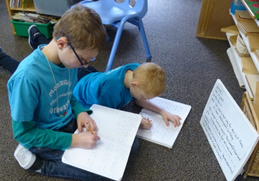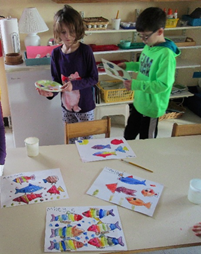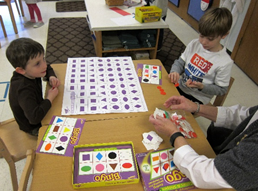
Notes from Head of School
by Ms. Alena Baradzina


The Montessori classroom is a place where teamwork and respect are continually fostered. During this time of the year, we are fortunately observing more and more team work in all classrooms.
Many of the students understand

that they have to be very helpful and respectful to their friends,
able to listen and hear them, and be open to suggestions while working together as a team. They learned this through real life classroom experiences.
Africa Study Presentation by Elementary Students
Another great example of teamwork was the preparation, organization, and hosting of the Africa Study Presentation that was done by our Elementary students this February.
Part of the Africa Study Presentation
News from the Elementary Class
(North Room)
by Ms. Amber
“We must help the child to act for himself, will for himself, think for himself; this is the art of those who aspire to serve the spirit.” ~ Maria Montessori
It is hard to believe the school year is two-thirds passed. February was a fast-paced blur! It seems we still have far to go, yet we really have come so far in our studies this year.

The switch back to using a weekly work plan seems to be a successful change for most of the students. Yes, students have choices, but not working or doing whatever they want to do are not choices. The path to being self-controlled, self-motivated, and independent lies in work, and sometimes it is hard. I use the analogy of a baby learning to walk. Yes, the baby falls and it may hurt, but the baby tries again and does not give up. Students can be just as successful when they keep on trying and work hard.

If you are seeing work plans with little work initialed or checked off by the teacher, talk to your student about his or her work effort. The student cannot have the next presentation/lesson if adequate practice of a prior concept has not occurred. We need students to practice learned concepts and move forward in their learning. Parents can help drive this learning process with frequent, gentle encouragement and with the consistent expectations that their student is at school to work hard to complete their school work.
This past month, the highlight for students was the Africa presentation. Wow, what a fantastic job they did! It was amazing to witness the ideas, mentoring, creativity, teamwork, the increased confidence with public speaking, and the support of each other in a process like that. Thank you for being a supportive audience.

It has been a tough month for attendance. How germs spread by coughing sneezing, nose-blowing, and using the bathroom was discussed. Students were shown the proper hand-washing technique, and the need for proper hand-washing has been repeatedly reinforced. This ties in well with the study of health and wellness. Please reinforce hand-washing outside of school, too.
The touch of spring-like weather set the tone for continued Botany studies, as signs of spring reinforce the learning. Animal studies will move from vertebrates to invertebrates. The health and wellness study will be completed. The water cycle and a bit of physics will be on the plan for this month. Then it is time to study Europe.

Daily writing will become a focus, as students work toward copying and/or creating proper sentences. The ideal outcome is composing as many paragraphs as the student’s grade in school. (For example, third grade = 3 paragraphs. A paragraph usually consists of five to seven sentences for Lower Elementary, and seven to twelve sentences for older students.)
With so much going on in the Elementary classroom, you really must plan to attend Demo Night on March 2nd. This is a great opportunity to witness your student demonstrating a work cycle or two, as well as an opportunity for kindergarten families to see what happens in the Elementary classroom. Looking forward to seeing you then!
February Photo Gallery Elementary Class
News from the Kindergarten
Extended Day Class
by Ms. Karen
“The environment must be rich in motives which lend interest to activity and invite the child to conduct his own experiences.” ~ Maria Montessori
Well, first, what spectacular weather! Of course, it interrupted my plans regarding study of snow and snowflakes! Think we can do it later next month? Would you have thought NO snow in February in Northern Illinois!

In math, several children are finding multiple ways of expressing the same number. In fact, one child found more than 20 ways to compose 10. This kind of activity leads to flexible thinking and, eventually seeing connections.
For example: 2+5+3 =10, 6 + 4 = 10, 2+2+6 =10.
Another popular activity: division. Yes, that is true! (Did you love division?!) But the Montessori classroom has a special activity that GIVES MEANING to the process. So, we can understand distributive division, even when it has a remainder!
In geography, we talked about and illustrated both strait and isthmus. We then got out our special, large geography book and looked for the straits and the isthmuses of the world. The children found quite a lot of them. Of course, in making their book, they wanted to illustrate it with drawings of people on a beach, boats going through the strait, etc. This is an introduction. It is always helpful for you to supplement geography lessons at home by getting out the globe and/or your geography atlas and look for the geographical landforms.

Matisse: our artist of the month. The children loved the story of Matisse, enjoyed the pictures he created simply using just a scissors. Popular because that art is accessible to the children. What fun to have colorful, playful, collage of shapes!
We have continued to enjoy the music of Mozart this month. Many of the children have chosen to make a book about Mozart as a final project. (Still dancing to his music).

Finally, although not much is final, there is the “mistake”. When doing the land and water form demonstration for strait and isthmus, I thought it would be more interesting if we added food coloring to make the water blue. It was, BUT, I had not noticed that the design of the strait made it impossible to pour the water out of the land form without spilling. So, when I went to empty the isthmus, the blue-dyed water ran out all over onto the white rug. An interesting moment.
Silence. BUT, one of the children said: “We all make mistakes.” It felt good that they could see that I also make mistakes. There must be a feeling in the classroom that problems are okay, that we can solve/fix them, that we can try new approaches or ideas. It all ended well as the blue dye came out in the wash with lots of bleach. We have to be able to try new ideas and know that sometimes they don’t work as expected. That’s okay. We fix the problem and go to continue our explorations.
Also, the 100 board is in demand at this time of the year. ”Simply“ putting all the tiles in order from 1 to 100 is the base. That itself is a challenge. But there are so many patterns to find once we have completed construction of numbers 1 - 100. One child was so excited “I found a pattern, I found another pattern, I found another pattern”. Patterns are integral to understanding and enjoying math. And they are “easy” to see using this material.
February Photo Gallery Kindergarten Extended Day
News from the Art Class
(Kindergarten and Elementary)
by Ms. Linda

Africa! This month in the elementary class we explored the art of Africa.

The students created African masks using collage and stamping techniques. We worked with the concept of symmetry to create masks that were balanced on both sides using cut paper. The masks were decorated with homemade stamps and paint.
The students also created three-dimensional Ndebele houses. The women of the Ndebele tribe in Africa paint geometric designs on their houses using bright colors. We used paper, markers, and "straw" to create our own version of these colorful homes.
In the kindergarten room, the students practiced color mixing using paint. We discussed the difference between primary and secondary colors and how to create secondary colors. The students drew fish and painted them by experimenting with color mixing. We are currently working on a mixed media painting and collage inspired by Claude Monet's "Water Lilies"
News from the South Room
by Ms. Andrea, Ms. Urana
“The education of the senses has, as its aim, the refinement of the differential perception of stimuli by means of repeated exercises.” ~ Maria Montessori
I want to begin by thanking all the parents, grandparents, and great grandparents who helped with the Valentine’s celebration. From donating festive stickers, paper, and extra shoeboxes to preparing a delicious snack, to volunteering your time and energy working with the children on fun activities…the morning was a success and the children had such a fun time. So again, thank you very much!
This year we spent quite a few days working on the valentine mailboxes. It was a multi-step activity that involved painting, cutting, gluing, sticking, and overall planning of how the box was going to look. It was very interesting to watch how the children approached this activity; some were very thoughtful and strategic on how they wanted it to look and took a lot of time attempting symmetry with their sticker work. Others were very minimalistic and only painted with one color and put a few stickers. And still others were the opposite of minimalistic and covered the box with as much as they possibly could. One sweet moment happened when our kindergartener Annabelle asked if she could make and decorate a mailbox for her classmate Shivain, whom she knew was is India visiting family and would not be able to participate in the activity. She spent so much time making his mailbox look beautiful and it was such an affirmation of how much these children truly care about each other.
At line time, we have been talking a lot about Days of the Week and Months of the Year. We have a song for both and we are learning them in both English and Spanish. For the months of the year song, the children are invited to raise their hands and wave when it is their birthday month. It seems quite a few do not know their birthday month, so it would be helpful, if you might remind them from time to time, when their birthday is.
Days of the Week
There are seven days, there are seven days,
there are seven days in the week.
Sunday, Monday, Tuesday, Wednesday,
Thursday, Friday, Saturday.
Today is Wednesday, today is Wednesday.
All day long, all day long.
Yesterday was Tuesday, tomorrow will be Thursday.
Oh, what fun! Oh, what fun!
We started expanding our food preparation this Month. We added avocados to our cheese quesadillas…not everyone enjoyed this new addition. We also made mini pizzas with bagels…most of them did love this. In addition, we added apple cutting and orange juicing to our practical life areas. There is an element of grace and courtesy with both activities, along with carrot cutting: the child can choose to 1) make juice for just themselves or for a friend also 2) bring their carrots or apples home, eat them for a snack or share them with their classmates. More often than not, the children choose to share. This presents a great opportunity for some key phrases: would you like…can I please have…thank you…you’re welcome, etc.
Montessorians always talk about “following the child” and how we must always observe each child to know where to guide them next. I am also a firm believer in being a lifelong learner myself, and I often tell the children that they are all teachers and that I learn from them daily.
This month two children helped guide me in two additions to our classroom. First, we had added a playdough activity in which the children could strengthen their hand muscles by working with the playdough. One afternoon, Violet decided to take a few pony beads from the bracelet making work, and hide them in the playdough. Rather than tell her that the beads are a separate work and not supposed to be smooshed in the playdough, I stopped and watched her for a while. She was having so much fun hiding the beads in the playdough and then digging them out; it was like watching an archeologist uncover bits of an ancient civilization. When she was finished, I told her what a great idea she had and asked her to help me choose several small objects to become part of the work. This has become so popular and the children are loving the act of hiding and digging out the objects.
The second instance of learning from the child, came when Eleanor came up to me and started singing “Head, Shoulder, Knees, and Toes” in Spanish. I asked her where she had learned that and she said her mom taught her after watching a video. So, that night I went home, found a video on YouTube, and the next day Eleanor helped me teach the class the song at line time.
Head, shoulders, knees, and toes,
Knees and toes.
Head, shoulders, knees, and toes,
Knees and toes.
Eyes and ears and mouth and nose.
Head, shoulders, knees, and toes,
Knees and toes!
Cabeza, hombros, rodillas, pies,
rodillas, pies,
Cabeza, hombros, rodillas, pies,
rodillas, pies,
Ojos, orejas, boca, nariz.
Cabeza, hombros, rodillas, pies,
rodillas, pies!
As Montessori teachers, we strive to always “follow the child” and are learning from them constantly, but these two examples really struck a chord with me and made me reflect on the importance of respecting these little humans as valuable contributors to our world. I’m so very lucky that I get to benefit from their knowledge and understanding every day.
February Photo Gallery South Room
February Photo Gallery Pre-K Extended Day Class
News from the East Room
by Ms. Carole, Ms. Christine
“Montessori taught me the joy of discovery… it showed you can become interested in pretty complex theories, like Pythagorean theory, say, by playing with blocks. It’s all about learning on your terms, rather than a teacher explaining stuff to you.
SimCity comes right out of Montessori... if you give people this model for building cities, they will abstract from it principles of urban design.” ~Will Wright, Computer Game Designer and Original Designer of The Sims

February brought many fun and interesting activities to our class. We enjoyed a citrus tasting activity thanks to Faye's family-Kumquats, Navel oranges, Mandarins and red grapefruit were tasted together as a line activity. No surprise that the Mandarins were the sweetest and the children's favorite! Thank you for sharing them with us!

We learned about groundhogs, also known as woodchucks and the story of seeing their shadow on the 2nd. Some of the children made their own pop-up groundhogs and we also worked on Parts of a Groundhog.
Thanks to our parent volunteers Eva Bar, who shared a craft with our class, Allison Doud who also brought in a craft. Also, many thanks to Jackie Radeni and Gina Formella who made our Valentine's morning a huge success! We love having our parents help in the class and your kids do, too!
It was an amazing experiment to have the children all participate in planting an Amaryllis bulb, which was brown and looked dormant. Every day the children watched it for growth. Finally, after a week, a tiny green sprout appeared. We then measured it weekly and boy did it grow! One surprise though, the flowers were white and not red like on the package!

We will celebrate Dr. Seuss birthday this month and look forward to our helpful parent volunteers again.

A new student Jacek joined us this month and we all welcome him to our classroom.
Supposedly the groundhog did see his shadow which is believed to mean 6 more weeks of winter - we were able to play outside with no coats a few days last week.
We will celebrate 7(!) birthdays next month - some are on the same day!
We thank you for a great month and look forward to more friendship and learning in March!
February Photo East Room
News from the Late Afternoon Class
By Ms. Donna

We learned about George Washington. He was our first president.
The camera had not been invented so pictures of him were painted by artist. His face is on our dollar bill.
We learned about Abraham Lincoln. He was our sixteenth president.
When he was thirty the camera was invented. His pictures were taken by a camera. His face is on our five-dollar bill. He was born in Indiana and moved to Illinois.
ART:

We made a ground hog picture with the sun shining so, he did see his shadow.
We had 2 fish heart pictures
We poked out “head pictures” of George Washington and Abraham Lincoln and glued them to a red, white and blue background
We traced a felt heart and then decorated it
SCIENCE:

Our question was –“What would happen if you mixed equal amounts of water and vegetable oil together?” Four students said they would not mix and eight students said that the oil and water would mix. So, we poured 1/4 cup of water and 1/4 cup of vegetable oil together and mixed them. We saw bubbles and then as we watch, the water went underneath the oil and the bubbles began to disappear.
MUSIC:
Song/Game - "Valentine, Valentine, do you have a letter"? While in a circle one student would walk on the outside of the circle while we sang the song and then drop the Valentine behind someone just before the song ended. That child would then deliver the Valentine to someone else as we sang. etc
NEW WORKS:
Animal Sound Bingo: We would listen to a tape if your card had the animal that would make the sound we heard you would cover it with a paper circle. The first student to cover four in a row was the winner.

Balance beam: walk across, walk while holding an egg on a spoon and not dropping the egg
BOOKS:
" A Book of Hugs" by Dave Ross
"The Biggest Valentine Ever" by Steven Kroll
"The Valentine Express" by Nancy Wallace
"Snow Valentines" by Karen Ruelle
"The Best Thing about Valentines" by Eleanor Hudson
Most of the Pre-K children are working with Language and Math materials. Proper letter formation / handwriting skills are a daily function - Kindergarten readiness is important at this time. Phonetic letter sounds and inviting these students to challenge themselves with success is a great lesson that instills self confidence as future, self assured students.
Moms and Dads....as a parent, I highly encourage you at this time to think what future plans you have for your child for their Kindergarten year – in Montessori environment it is truly an important learning window that builds on their skills / knowledge. More information will be forthcoming.
The basic areas we are focusing on at this time are Language / Writing / Phonetic sound knowledge, Math / Number recognition and equating a quantity of variables with the numeral, an awareness of global continents and culture, Animal habitats / traits in the winter months; we have identified Animal Tracks that we may actually see in the snow outside our own homes / school - we have rabbits and apparently raccoons on the playground here! No deer though, although they're highly desired!
We have explored Ocean Animals such as the Blue Whale, Sharks, Sting Rays and many other ocean creatures - the children seem to gravitate to this subject and we have added many books on this topic as well as art to supplement their interest in this topic. We added three part cards and matching objects to encourage their interest.
We have experienced various objects placed into water and then predicted which would "sink" or "float" and why.
Our classroom pet, an African Dwarf Frog who has been with us for about 5 years has a new habitat thanks to Isabella Vera's family - he/she is healthy and thriving in the new environment - THANK YOU!! Everyone is enjoying taking turns to feed and check on its daily well being.
We have enjoyed making snowmen / snowflakes (glitter is great!) and playing outside together with sleds and shovels this month. We wove yarn around mittens and read the story about all the animals that were able to squeeze into "The Mitten".
This last day of January, we get to celebrate Sidney's birthday and look forward to several more in February....
We are also looking forward to our Valentine's celebration on Friday, 2/12- if you are available and have some ideas for snacks or art projects to share with our class, please share with us - your children love to have you in our classroom to meet and share with their friends.
Thank you all for your continued support and communication in raising such wonderful people! It is truly a pleasure to watch them grow and succeed and flourish everyday!!
All the Best to You!
Notes from the Late Afternoon classroom:
Ms. Donna

January was our month for snowmen. We could find them everywhere.
Art: Icicles on blue paper: blue paper, glue and salt. It was fun watching the glue slide down from the top of the blue paper to see witch glue line would get to the bottom first. Then regular table salt was sprinkled on top of the glue.
Melted Snowmen: blue paper, glue, white paint, cut out hats, noses, scarves, and wiggles eyes. Step one was to use white paint to make a snowman blob, then they glued on a hat, eyes, scarf and nose.

Winter Color Line Painting: paint-- shades of blue and purple, paint brushes, white paper, blue paper, snowflake paper punch, and glue. Step one paint lines on white paper, while drying punch out white snowflakes, then glue white painted paper onto the blue paper also add the punched out snowflakes to the corners.
Paper Doll Snowmen: blue paper, glue, scissors, folded paper, snowman tracer, pen and orange, brown and black paper. Step one take the white folded white paper and put the snowman tracer on top and trace, then cut on the lines only, (you should end of with four snowmen holding hands) glue the four snowmen on blue paper and add details
Our Famous Person this month was Martin Luther King, Jr. We learned that he had a dream. He believed that all people should be treated the same. We did a poster showing our hands over lapping each other and got to paint them using water colors.
Gym Activity: Using two paper plates as ice skates we skated to music.
New Works: Different magnet works, circus, farm, fairy tales, seasons, a variety of puzzles.
Stories: “Snowballs " by Lois Ehlert And the " Snowy Day"
Science: We tried two recipes for making snow. #1- baking soda and shaving cream. #2 - baking soda and conditioner. Number 2 worked better.
We also put milk into a bowl and added different colors of food coloring and then added dish soap. When we added the soap the colors started moving making more colors as they ran into each other. We then tried putting paper on top of the bowl and we made a marbleized looking paper.
